How to Build a Software Product: Full Guide

The realm of quality software product development has been around ever since the technological niche came into existence, opening doors for business owners to step proudly into the market and cater to their audiences. Given that the sector’s evolving complexities require attentive study, we prepared this comprehensive guide on the topic.
If you are looking for custom software product development with effective functionality that is aimed at solving the problems of users, you need to be aware of all of the essentials that encompass this area of expertise. We intend to spotlight the main points, developing the idea from the term definition to the emerging trends for digital products.
In our overview, you will learn about product software engineering, diving headfirst into the creation process. Keep reading to get equipped with valuable insights that can change the way you approach software development services.
What is software product development?
Before we hit it off with the crucial parts of the review, it is best to level with you and start by discussing the definition and purpose of such a practice. The coding of a product is a strategic operation that, in simple terms, turns an idea into a fully functional solution from the very beginning to the end stages of deployment.
You can work with trusted product development partners to lay the foundation of a good or renovate an existing digital good but the lifecycle of the creation remains a data-focused and user-centered approach where discovery plays a pivotal role in getting the goals and targets of the project right and well-understood by the provider of software product development service.
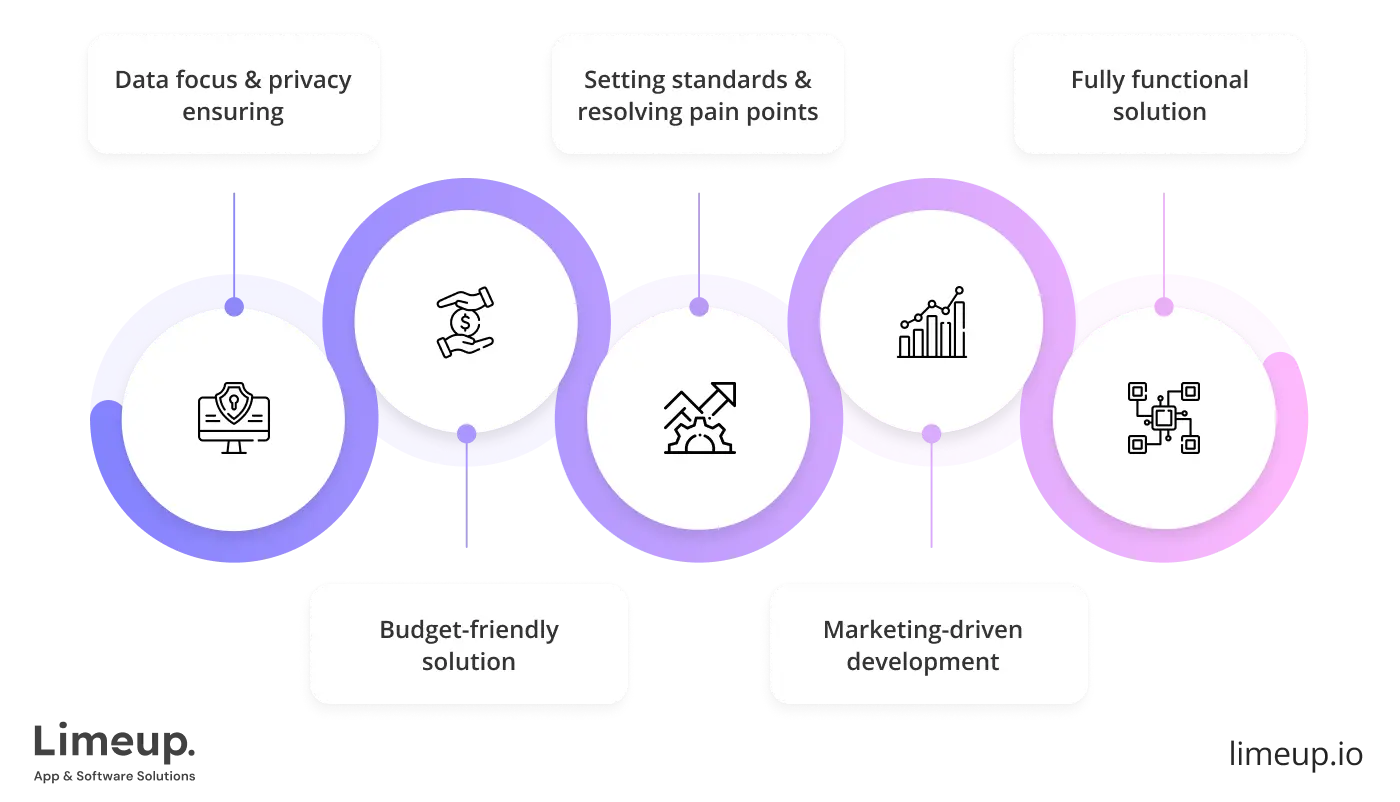
When every member, first and foremost, including the client, is fully on board, you agree on the appropriate tools and technologies for both the design and engineering stages. This is where the practical building of features and main functionality starts to unfold and marks the procedure.
In today’s world, the attention that is paid to security is paramount in making sure the sensitive and private data of consumers is safeguarded and not subjected to vulnerabilities. Rigorous testing to identify and neutralize any potential risks and implementing the highest measures of protection are important phases of creating a software product.
As the outcome of the entire endeavor, the end result is a polished system that adheres to the requirements, sets a standard in the competitive market, resolves the pain points of the target audience and complies with the established regulations.
It is not hard to see why entrepreneurs from all walks of life are interested in dabbling with product formation. If that sounds appealing to you as well, let us move forward with unearthing the roadmap of bringing the blueprint into being further in our brief.
Types of software products
Let’s take a look at the most widely known digital assets that you see and use every day.
| Type | Primary users | Main purpose | Key features |
| Internal tools | Internal staff | Streamline internal workflows | Custom dashboards, scheduling |
| B2B SaaS | Business clients | Enhance business operations | Subscription, integrations |
| B2C apps | General consumers | Engage and maintain users | Mobile-friendly, engaging UI |
| Enterprise platforms | Large organizations | Manage complex, cross-functional operations | Highly customizable, secure |
Software solutions vary widely in purpose and design, serving distinct groups from certain workers to global corporations and individual consumers. Understanding these categories helps clarify how each type supports specific operational goals, needs, and business priorities.
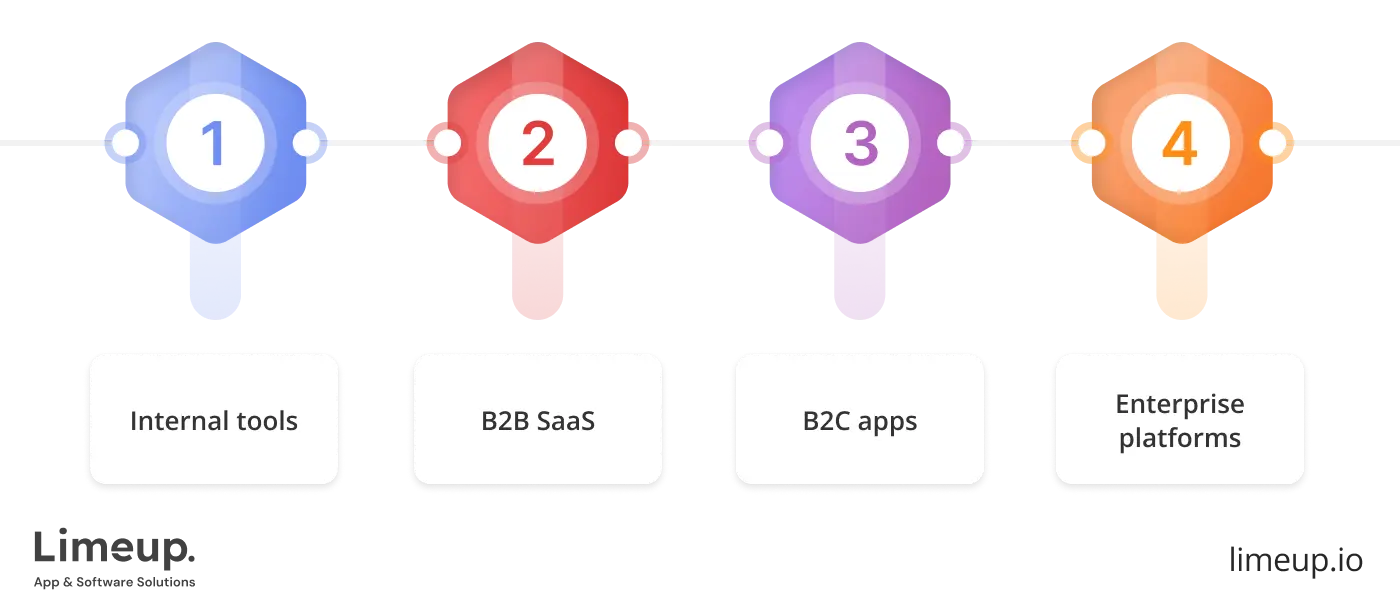
- Internal tools
Internal tools are applied within an organization to keep things rolling smoothly. Custom dashboard, analytic portal, a staff schedule, HR, or finance app, all of them make internal work more efficient — from removing bottlenecks to simplifying daily operations, none of which are meant to be accessed by an external user.
- B2B SaaS
B2B SaaS platforms are subscription-based services designed to make a measurable impact on businesses, supporting sales, marketing, customer servicing, and operational efficiency. In software product development, they are highly flexible with configuration, role assignment, and integrations; these platforms fit just right within corporate environments. In terms of priorities, it is focused on reliability, scalability, and seamless integration within existing enterprise toolchains.
- B2C apps
These cater to end consumers who desire a casual yet entertaining experience. They can be anything from mobile fitness apps to social media hubs, including productivity and entertainment applications. The objective here is simply to capture the imagination and hold onto that mass user base for profitability, turning an app into a daily habit for its users in terms of product development for software.
- Enterprise platforms
Portals of this kind are large‑scale and highly customizable software ecosystems capable of protecting intricate organizations. The core business processes are ensured to run smoothly, from ERP to supply chain management and human resources, cross-departmentally, and across regions.
These should be made to offer longevity, strength, and security with a certain degree of freedom so that corporations can grow without hindrance and future-proof their core operations as they expand.
How to develop a software product: 7-step guide
From the first discussion of your aims with a crew to getting it realized, there are quite a lot of actions to take, which go one after the other and require utmost attention. Familiarize yourself with the blueprint we summarized:

Step 1. Research
During this phase, engineers actively work with contractors in order to clarify their expectations fully, the idea that stands behind the project and the goals. Yet, it’s only one side of the venture. To make the right choices, executors gather information about consumers’ preferences to form an applicable deliverable.
Step 2. Conceptualization
When the main milestones are determined, an engineer approaches the stage of drafting the structure of the future app, from its functionalities to the entailed technology stack. Not only does the core of it matter, but additionally, the aspects like timeline of carrying out the undertaking and approximation, which are thought out during this stage with the intention of having a bigger picture.
Step 3. Design
With the ready concept, custom software product development turns to crafting the visual facet of an application. It includes a range of tasks, beginning with drafting the journey, placing all necessary buttons in the proper corners and making sure that the usage is intuitive and proceeding to paint the main imagery elements. With a few adjustments, orderers have an opportunity to receive a prototype of a system from software development companies.
Step 4. Development
As soon as the final look is accepted, this is a cue to make the workaround fully functional by embedding the user interface and server components. Such points as third-party integrations, protecting measurements and processing information instruments are what you need to expect.
Step 5. Testing
When you create a software product, whatever the manner in which all the preceding procedures are taken, there’s still a possibility of an error appearing in the future since code is a very delicate mechanism and one extra symbol can lead to various problems. By conducting compatibility and security checks, coders eliminate bugs and ensure good performance.
Step 6. Launch
To enable customers to get access to the program, it should be transferred from the development environment to the space where it’s open to consumers, with the chance of obtaining it from the App Store and Google Play or finding it in search engines.
Step 7. Update
After the executable is available to your audience, there are still things to do. As standards change, as well as technologies, the app should be maintained, with all adjustments on time. Monitoring the running is not less important than writing the code itself if you are interested in durable progress.
Best practices in custom software product development
The setting and mindset required for digital product success go hand in hand. Outcomes are just one consideration: One has to architect for resilience, code for adaptability, and implement some form of version control for shared ownership.
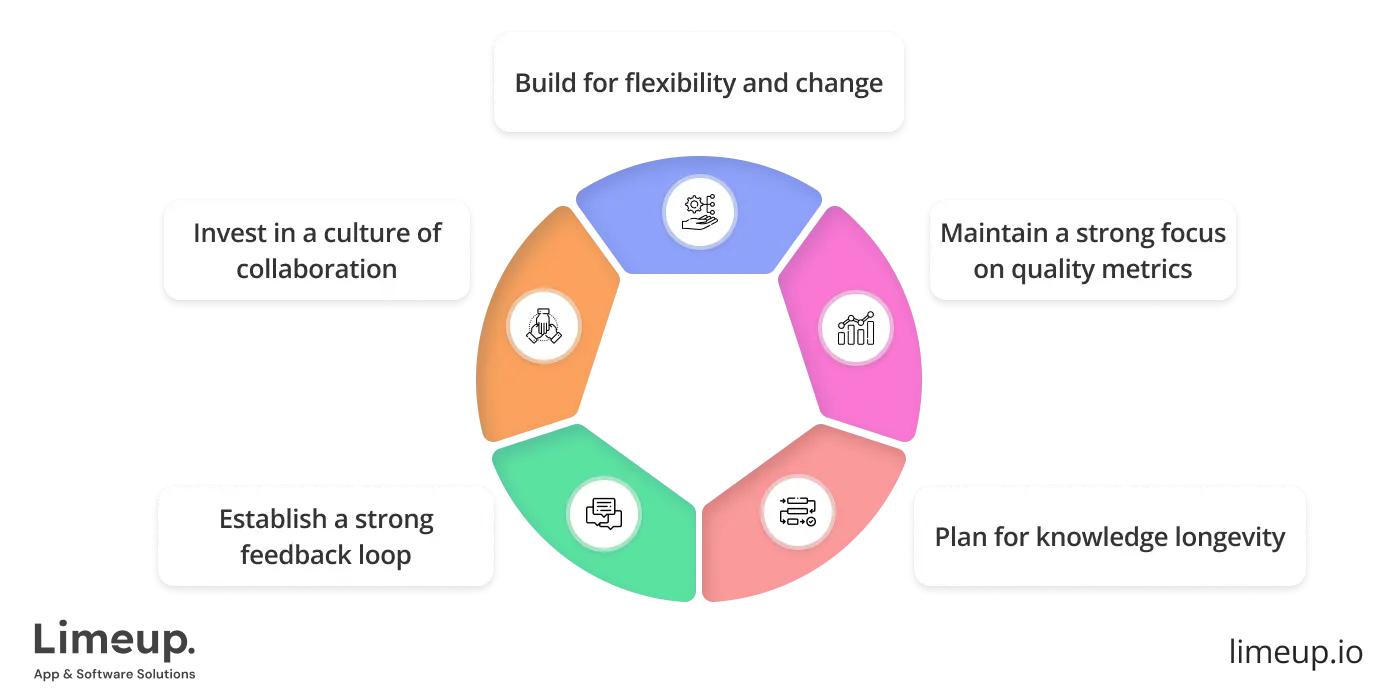
This way, the team stays on the same frequency, challenges are realized and debugged, and deployments continue regardless of a turbulent sea or a sudden spike in system load.
- Establish a strong feedback loop
Throughout the project, pay close attention to your stakeholders, end-users, and the software developer to hire and keep stirring input beyond the initial requirements that are met so that the solution can evolve together with its audience, starting with conception to final additions. This ongoing dialogue allows teams to address previously hidden pain points and shift priorities in product software development very quickly toward long-term relevance.
A trusting and transparent relationship will ensure that the client becomes a champion for the solution, helping it regain momentum after some initial testing.
- Invest in a culture of collaboration
Treat the process as the management of a big team by balancing a serious attitude with pragmatism so that developers, UX designers, QA engineers, and product owners unite under a common vision.
This atmosphere builds trust and open communication, thus encouraging the raising of red flags or suggestions for improvement early on. Moving in this direction will result in a smooth workflow wherein every role is respected and every contribution matters.
- Build for flexibility and change
In this ever-evolving world, nothing is steady in terms of high-tech innovations and their influence, so it will be a nice consideration for you to think two steps ahead about what additions can benefit your new product development software. The digital good thus becomes future-proof, with a relatively loose codebase that can easily evolve along with changes in technologies and user requirements.
- Maintain a strong focus on quality metrics
Give focus to code quality and performance as something worthy of first-class treatment, integrating metrics such as load times, crash rates, and user engagement KPIs into daily monitoring, with no excuses for accountability.
Making quality measurable gives teams the option to search and mend an issue before it snowballs into something desperate, securing user experience and brand reputation. Conversely, this trust-building approach builds a product that is far more resistant to pressure in markets.
- Plan for knowledge longevity
Put your thoughts into developing mechanisms that reduce the risks of knowledge silos by maintaining well-structured accessible documentation and promoting an appropriate team environment that allows for any squad member to be adaptable and calm in cases of turnover or change in roles.
This methodology, therefore, does not just assure continuity; it keeps the engine running smoothly and simplifies onboarding, thereby diminishing long-term risk even in software product development for a startup.By making knowledge shared, one lays the blueprint for sustainable growth, so the product and team will become self-sufficient well after launch.
How long does it take to build a software product?
This table maps out typical engineering lifecycles for digital goods based on outlined factors and features. It highlights how functionality, integrations, and scalability drive the clock on creation time, shaping the journey from simple prototypes to robust, enterprise-grade systems.
| Product type/Complexity | Estimated development time | Typical features and scope |
| Simple prototype/Basic MVP | 2 to 3 months | Internal tools, basic MVPs, web dashboards, single-feature mobile apps, utility tools. |
| Mid-level engineering/Product software | 4 to 9 months | B2B SaaS platforms, B2C apps with user authentication, payment systems, analytics dashboards, real-time notifications, APIs. |
| Advanced systems/Enterprise platforms | 10 to 18+ months | Enterprise platforms, marketplaces, custom ERP/CRM systems with multiple user journeys, granular access control, security. |
Details that affect the delivery time
The timeline for creating a software product hinges on multiple intertwined factors, each influencing the pace and precision of the final outcome. Navigating these variables effectively is crucial to keeping the project on track and delivering a robust solution.
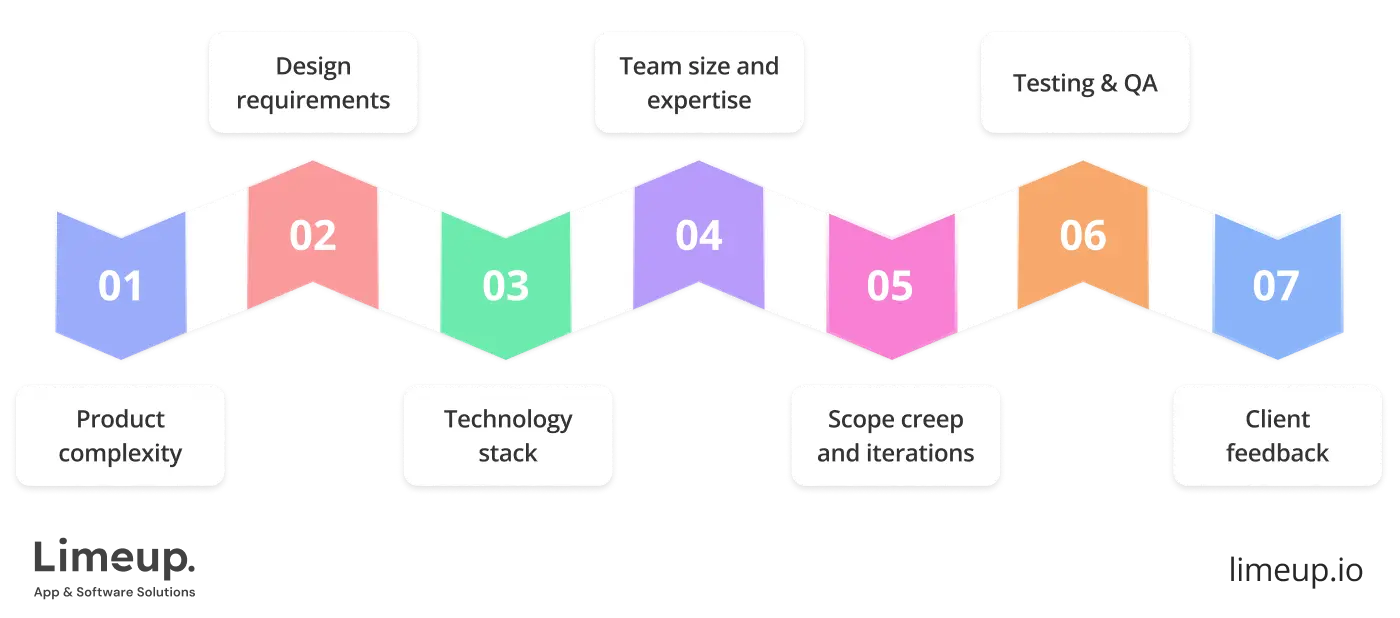
Product complexity: The more features, integrations, and workflows your app supports, the longer the time needed to make it work appropriately, and then each component must be thoroughly designed, developed, and tested.
Design requirements: Custom UI/UX, animations, responsive layouts, accessibility, branding alignment, any of which may appear sleek and are very difficult for the front-end team, and could add weeks to the development timeline.
Technology stack: Some frameworks can help you hit the ground running (e.g., Flutter for cross-platform apps), whereas older or less-used stacks may have teams reinventing wheels, thus losing time.
Team size and expertise: A team of seasoned professionals with organized controls acts like a finely tuned mechanism within a software product development company, capable of faster and more predictable deliveries than a smaller, junior team still finding its feet, working on the same area.
Scope creep and iterations: The timelines spiral as ideas germinate and stakeholders keep on moving the goalposts, sneaking in features with changing priorities mid-flight and absolutely no roadmap rework.
Testing & QA: Mission-critical apps, especially in healthcare and finance, demand full confidence from teams, since there is no room for hesitation when it comes to validation, security checks, or regulatory compliance.
Client feedback and review cycles: Projects with continuous review cycles and stakeholder involvement normally tend towards late deliveries.
By understanding these key elements, crews can better anticipate challenges and streamline their development process for optimal results.
How much do software product development services cost?
As much as we wish there was a cut-and-dry cost that could be applied to a specific type of output, the matter of price formation is filled with a lot of influential nuances that ultimately decide the fate of your budget. In fact, the only way to obtain a concrete answer as to how much you are going to expect to pay for the project is to direct this question to your contractor.
Still, we don’t want to leave you hanging, so we will lift the curtain of secrecy on this topic in our outline by talking about factors that make up the expense outline and the average pricing spans you are likely to fall under. The first ones come within the venture itself: its complexity, type of platform needed, technologies and so on.
But first, let’s look at approximate outlays we gathered in the table below, taking into account functionality and grade of deliverables:
| Type of software | What goes into it | Average costs |
| Basic | Login form, dashboard, notifications, search bar, etc. | $15,000–$35,000 |
| Medium | 2FA, payment gateways, eCommerce features, chatbots, etc. | $40,000–$70,000 |
| Advanced | Enterprise-grade elements, data encryption, predictive analytics, AI integrations, personalization, etc. | $80,000–$150,000+ |
Now, let’s discuss what makes the ranges so wide. If you are looking to develop a software product that is complex, meaning it contains a high degree of customization, intricate attributes, robust functionality, then the expenditure plan will inevitably skyrocket as you pay for advanced expertise from the professionals who carry on tedious tasks.
The type of platform, meaning you want a mobile app, a website, custom software, etc., is also going to affect the final numbers as the actual programming for each kind looks different and demands distinguished knowledge of tools, programs, trends, market demands and more.
As for the high-tech tools used by every top software company in the UK, depending on the type of offering you are asking the tech savants to create, they will employ a variety of stacks including programming languages, frameworks, libraries and other tools that may necessitate a certain tier of experience and understanding might be separate in pricings.
When it comes to the outside forces that are not dependent on your initiative, the charges that software product developers put upfront can either put a strain on your spending plan or become a saving grace. To get a sense of what you are getting yourself into, you have to be aware of the kinds of payments for the product which include:
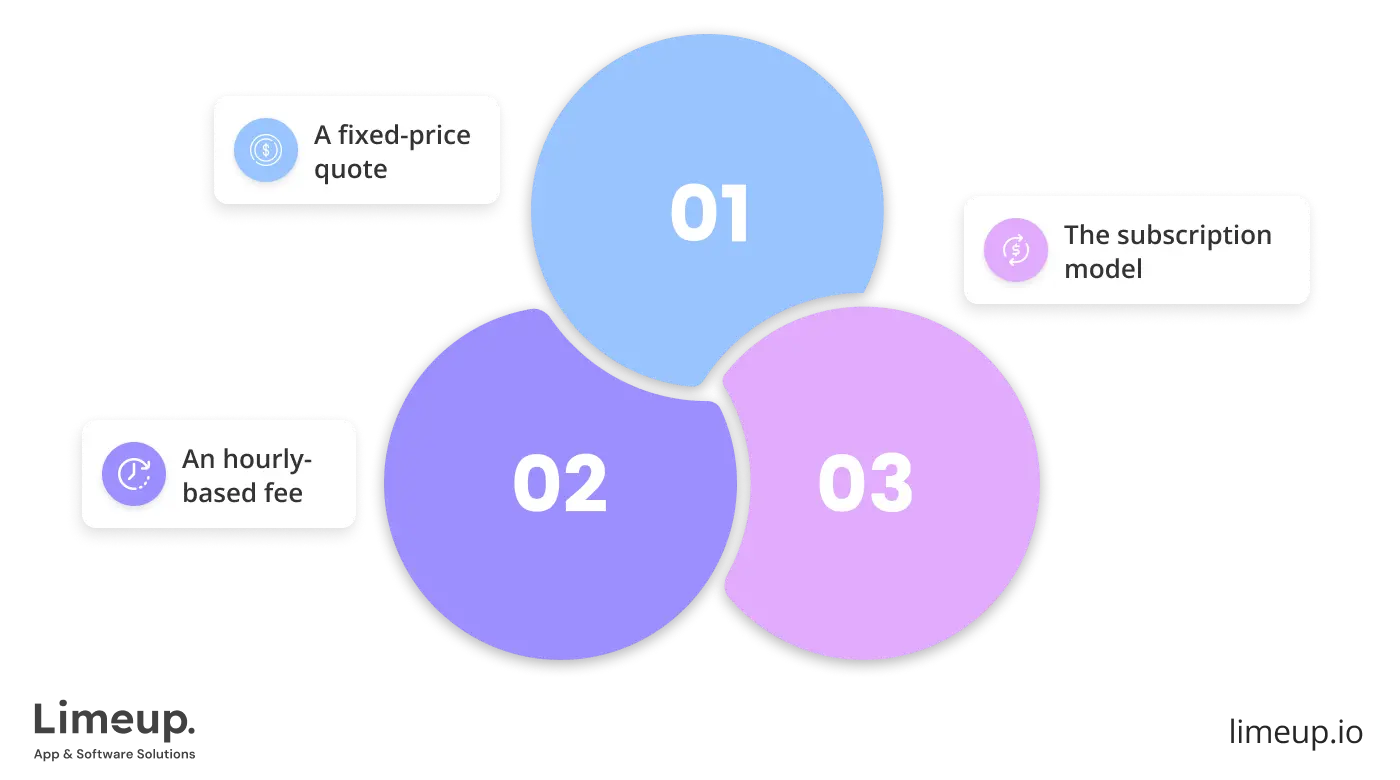
- An hourly-based fee means the engineers present you with a tariff you have to pay for each hour they spend on your undertaking, whether for each specific executor or as a team.
- A fixed-price quote of engineering and product development software entails the provider analyzing your assignment and extending an unchangeable quote that encompasses the entire engineering and implementation process which you cover upfront, in parts or after the software completion.
- The subscription model, as the name suggests, allows you to pick a suitable plan for the development and transfer a monthly charge for the work or even be set as a milestone where you compensate each finished stage of architecting.
There are also other types of hybrid payment models for software products development and no doubt about it — each has its own set of benefits and cons.
Hidden costs you might not expect
At first glance, everything may seem simple, since you get what you are paying for, but some details may not be announced, so let’s take a look at what can additionally influence the final cost behind the technological scene.
- Maintenance & updates. Your software has to be in continuous routine maintenance post-launch — bug fixes, security patches, and compatibility updates all have to be maintained so that it keeps up as platforms evolve.
Annual maintenance retainers: ($5,000–$30,000)
Developer hourly rates: ($50–$150).
- Security, compliance & certifications. Complying with GDPR or HIPAA while developing a software product means routine audits and security reviews have to be attended to.
Compliance audits ($2,000–$15,000)
Penetration testing ($3,000–$10,000).
- Third-party services such as payment processors, analytics tools, or mapping APIs might have a lot of influence on the final check with the hike in traffic and usage.
API usage ($100–$2,000/month)
Premium SaaS levels ($500–$5,000/year)
Data storage add-ons ($100–$1,000/month).
- Server, hosting & infrastructure. Reliable servers, databases, load balancers, and backups are needed for your app’s foundation and must be able to scale on demand as traffic rises.
Cloud servers (from $100 to $5,000 per month)
Load balancers ($30–$300 per month)
Automated backups ($10–$100 per month)
Disaster recovery services ($500–$5,000/year)
- Licensing, SaaS tools & frameworks. Frameworks, design platforms, and custom software product development services in SaaS usually come with a subscription.
Tool licenses on an annual basis ($300–$3,000)
SaaS subscriptions of the premium variety ($25–$1,000 per user)
Licensing for plugins or libraries ($100–$1,500).
Trends in product software engineering in 2026
The digital sector is not exempt from accumulating a certain standard and emerging tendencies around it, which point toward the specifics of this business. Some shifts have been around for quite some time while others are only gaining center stage in light of recent years.
We have researched and compiled an extensive explanation for each of the five most dominant currents that we are encountering in the industry now:

Artificial intelligence implementation. The role of AI and ML in the modern landscape of offering to market is hard to deny, as its roots seem to expand. Now, when it comes to software product creation, AI has been gaining precedence for its capability to automate routine tasks and operations.
This means that such integrations can ease the load off the backs of engineers by taking care of, for example, automated testing, some parts of generating the code and many other procedures that would have otherwise taken a long time to handle via human power. In fact, research suggests that 72% of responders are using AI in at least one of their departments.
Focus on user-centricity. Speaking of journey, this has hardly been a novelty but more so a necessity with any digitalized product since if consumers find your offering to be hard to navigate or unable to solve their pain points, they simply will not use it.
Low-code development. The low-code or sometimes even no-code practices are based on pre-made solutions and integrations that can significantly speed up time to market without compromising on the quality of the program. More and more tech gurus are turning to these practices to limit the amount of time needed to write code for basic functions — that’s how to create a software product in no time.
The platforms for low coding have been spreading like wildfire over the last several years and show no signs of slowing down, as they keep the possibility of human error to a minimum.
Sustainability practices. The last aspect we want to touch on is that you should take into consideration the rise of demand for sustainable and environment-friendly practices. As the climate changes and consumers are becoming more mindful of their daily habits, they are turning to brands that support their worldview.
You can opt for smaller changes at first, such as energy efficiency, contribution to green initiatives and other options for minimizing the impact the production has on our planet.
Limeup’s software product creation case study
The client needed more than just a blockchain platform; they envisioned an NFT workspace, Mintplicity, that could scale, wherein creativity could never be forced into a one-size-fits-all template. Having that bold vision, the client went to Limeup to build a digital environment in from scratch that could actually stand out for the edge in originality.
Business challenge
In this fast-moving environment, almost all software product development solutions play it simple, with cookie-cutter templates that restrict innovation. Mintplicity felt there was a market unserved: it wanted creators, collectors, and brands to have a platform where every NFT experience could literally be branded anew, freed from design constraints.

They are faced with the challenge of creating a front-end over a system architecture capable of infinite permutations, while secure and friendly to use, and able to evolve with surging demands in a decentralized user base. Everything had to work like clockwork: no factory feel.
Key business challenges included:
- Eliminate all creative constraints: Set up an untethered designing/minting interface, dispensing with any assurance of pre-cooked templates which could have stifled creativity. In short, create an environment where users could truly color outside the lines and freely craft NFTs with full artistic control.
- Ensure scalability right from the get-go: Build a system that could scale anytime it is demanded, handling growth seamlessly by setting down firm foundations for horizontal scalability as user traffic and asset complexity go into overdrive.
- Develop an intuitive UX for the uninformed: Building a software product to allow a plug-and-play experience that would feel natural even to a non-blockchain person, ensuring the interface does not flash the poor users deep into the abyss.
- Maintain grit and spirit under load conditions: Ensure that the platform will hold its ground when traffic surges in, handling a high number of transactions, helping in real-time previews and rendering of assets to minimize the load time and related issues.
- Future-proofing of the platform: Design for tomorrow, allowing any new NFT standards, use cases, and third-party integrations to slide right in without having to uproot the tracks and start anew.
The custom solution we built
Being one of the best companies that offer bespoke software solutions, we took a zero-template approach, realizing there was nothing existing that satisfied their needs; hence, our engineers decided to begin from scratch with foundational UX research, mapping the behaviors and decision paths for NFT creators and users.
From there, almost every software product developer on this project made a contribution to the modular design system or the visual DNA of the platform, allowing UI components to snap together like LEGO blocks while still giving way to brand coherence and adaptability.
Limeup crafted a front-end architecture that can scale without batting an eyelid. There was more to it than just addressing today’s issues: laying a technical foundation capable of going with the punches as blockchain standards and user expectations evolve. Key project undertakings included the following:
- A performance-tuned front-end to scale up in a jiffy as per demand and race at full speed for high-profile events.
- A dynamic design system with Web3 aesthetics and best-in-class usability standards.
- UX frameworks are built to smooth operations for NFT creation, previewing, and listing workflows.
- The front-end was developed using React and Web3.js to ensure seamless blockchain integration and a responsive UI.
Outcome & value delivered
What came out of this was beyond the front-end merely; it was more of a digital launchpad with firepower under the hood. We made everything to build a software product that is now an easy runway for NFT creators who impart expressive-artworthy one-off assets to mint without technical/legal hindrance.
Custom design and architecture not only keep up with the brief but also set the precedent for future-centric innovations, and if you want something similar, you should think about where and how to hire a senior back-end developer as well as other respective professionals.
In the fast-moving landscape that is NFTs, Limeup found a bespoke, highly adaptable solution that now lets the creators think outside the box instead of fitting into one.
Ready to turn your idea into a real product?
Getting into the trenches of what hides behind the most common questions clients have when it comes to software product design and development can ease the load off your mind and put your thoughts in the correct direction. Now it is clear that there is a multiplicity of benefits you can reap and detriments to be aware of to seamlessly avoid.
Going beyond the constructive breakdown in regard to the meaning and purpose of this type of development we have shown you the way to approach your product-making taking into account some of the trending tendencies that people are looking forward to and those that may raise your chances of getting off on the right foot with your launch in this competitive niche.
On top of that, our overview lifted the veil of secrecy in regard to the price formation for product creation and gave you estimated numbers to base your realistic budget expectation on. If you want to begin the realization of your plan and start building software products, contact Limeup. We’ll pave the way to success for you!

